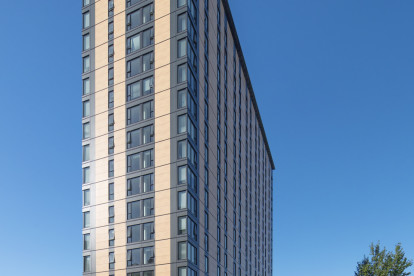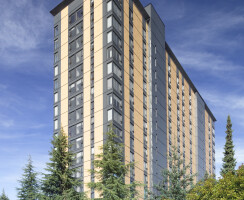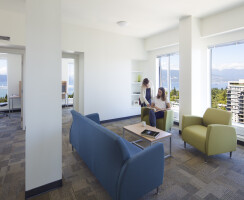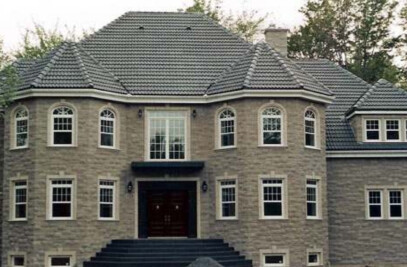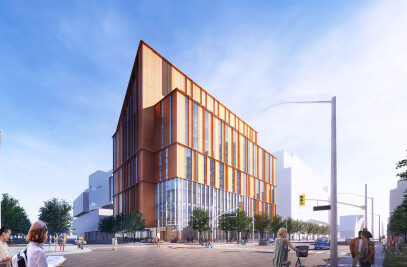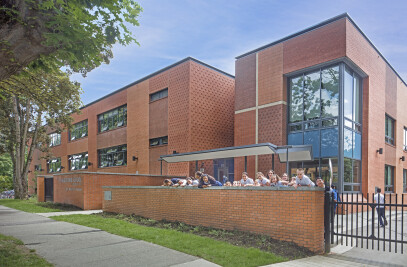World’s Tallest Mass Timber Tower
At 18 storeys and 53 meters in height, Brock Commons Tallwood House is a 404-bed student residence building located on The University of British Columbia Point Grey campus in Vancouver, BC, Canada that officially opened for students in July of 2017. The project is the first completed in Canada under the 2013 Tall Wood Building Demonstration Project Initiative sponsored by Natural Resources Canada. Brock Commons aspires to be a model for a future that features extraordinarily ordinary mass wood buildings that are quick, clean and cost effective to construct and which maximize carbon sequestering and reduction of greenhouse gas emissions in cities.
Extraordinary for its height—which makes Brock Commons the world’s current tallest mass timber tower—the building is also extraordinary for the speed at which its structure of glue laminated timber, cross laminated timber (CLT), and prefabricated facade went up in only 66 days. At 2,233 cubic meters, the building utilizes an extraordinary amount of timber that stores an impressive 1,753 metric tons of carbon dioxide and avoids production of 679 metric tons of greenhouse gas emissions. Another extraordinary achievement is that the innovative project demonstrates a mass wood building can be comparable in cost to a traditional concrete building.
To make the building possible the provincial government of British Columbia issued a site-specific regulation that allowed Brock Commons to use mass timber in a high-rise application, which resulted in a building that is even more resistant to fire than an equivalent concrete or steel tower. Russell Acton, principal of Acton Ostry Architects states, “Key to receiving approvals and realizing economic viability for the timber tower was a “keep it simple” design approach that makes the building appear ordinary—extraordinarily ordinary—through the encapsulation of the wood structure with gypsum board.”
The rectilinear slab-form reflects the massing and character of existing Modernist buildings on the UBC campus. The facade is made up of prefabricated panels with pre-installed windows. There are four distinct L-shaped corner panels with corner-wrapping windows. A high-pressure laminate cladding, consisting of 70 per cent wood fibers and thermosetting resins, creates a pattern of alternating light wood and charcoal-coloured vertical striations. A metal cornice crowns the building.
Social and study spaces are located at the ground floor level and at the uppermost floor where the glulam column structure has been left exposed. An extensive CLT canopy runs the length of the curtain wall base, revealing the warm wood finishes of the amenity spaces within. The elevator lobbies at the student living levels are clad with the same material used at the exterior. Hallway finishes feature natural wood doors and a palette of rich umber and ochre carpet and paint accents. The 305 studio and quad-unit interiors are spare and simple with bright white finishes and warmly-hued carpet and countertops. The quintessential west coast ocean and mountain views are spectacular.
The growth of mass wood in the building industry is still in its infancy and will require time to achieve comparable resolution of design, construction and cost optimizations that have evolved over decades for concrete and steel. For the industry to grow, mass wood buildings must become a genuine option and preferred choice for owners, architects, developers and builders; they must be affordable to design and to build. Russell Acton explains, “To be truly environmentally meaningful, mass wood structures must be incorporated into buildings of all types and sizes, from the audacious to the everyday—whether the wood is exposed or not.” Acton concludes, “It will be the continued evolution of simple, straight forward, extraordinarily ordinary mass wood buildings, such as Brock Commons, that will be the foundation upon which mass wood will make a genuine and meaningful contribution to the future sustainability of our cities.”
Brock Commons Tallwood House was designed by Acton Ostry Architects of Vancouver, BC with Architekten Hermann Kaufmann of Austria as tall wood advisors, Fast + Epp as structural engineers and GHL Consultants Ltd. as fire science and building code consultant. The project development manager was UBC Properties Trust and construction management was by Urban One Builders.


